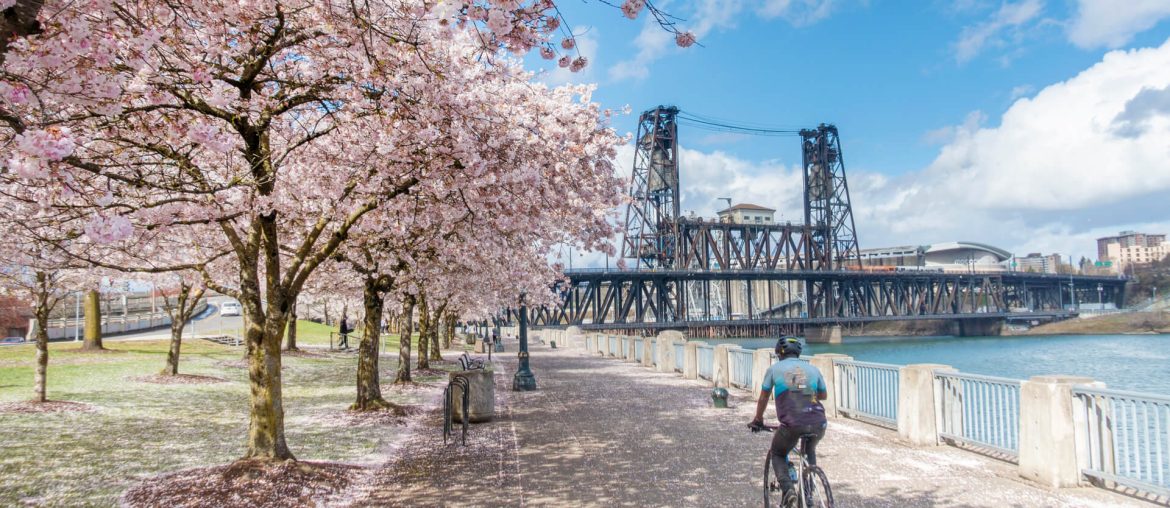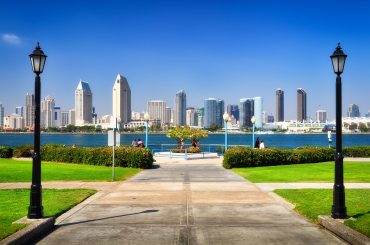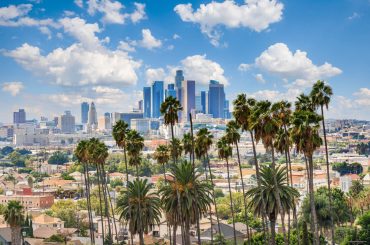If sustainability drives your everyday decisions — from the foods you eat to your transportation habits — perhaps you’ve considered relocating to a city that spotlights environmental health as much as you do. Whether you’re planning to move or simply researching green cities around the U.S., this list recognizes some of our nation’s most eco-friendly places to live.
1. Portland, Oregon
In an effort to encourage more walking and biking, Portland has over 400 miles of multi-use paths, bikeways and neighborhood greenways, as well as over 92,000 acres of green space.
Portland has the highest biking-to-work rate of any major U.S. city. It was also one of the world’s first cities to develop a master plan for pedestrians and cyclists. A quarter of the city’s workforce commutes by carpooling, biking or taking public transportation.
In 2017, the city also set a goal to use 100% renewable energy by 2050. Half of Portland’s power comes from renewable sources and 67% of the city’s waste is composted and treated locally. More than 30 of its buildings are certified by the U.S. Green Building Council.
2. San Diego, California
San Diego stands as a beacon of eco-consciousness, seamlessly blending urban living with environmental stewardship. Renowned for its commitment to sustainability, this vibrant coastal city boasts a tapestry of green initiatives and practices that weave through its very fabric. From its extensive network of bike lanes and electric vehicle infrastructure to its progressive waste management systems, San Diego prioritizes reducing its carbon footprint.
San Diego is widely regarded as one of the country’s greenest cities for several reasons:
- Focus on reducing greenhouse gas emissions: As part of the first strategy of its Climate Action Plan — “Decarbonization of the Built Environment” — the city of San Diego aims to minimize greenhouse gas emissions from buildings across the city and improve indoor air quality (IAQ). It covers measures to address emissions in both existing buildings and those under development.
- Commitment to renewable energy: The second strategy of San Diego’s Climate Action Plan — “Access to Clean & Renewable Energy” — emphasizes the city’s objective to achieve 100% renewable energy. This strategy includes ambitious goals to convert all vehicles to electric.
- Solar power initiatives: San Diego is one of the top five solar power producers in the country.
3. Denver, Colorado
The Mile-High City hosts one of the country’s most successful environmental programs, Denver Recycles. City workers gather over 26,000 tons of recyclable materials, generating an average annual revenue of $800,000.
Denver is also a hotspot for sustainable education opportunities. It houses two national research centers that offer tours and exhibits about renewable energy and the Earth’s climate — the National Center for Atmospheric Research and the National Renewable Energy Laboratory. Denver also has a world-class science and nature museum — the Denver Museum of Nature & Science.
4. San Francisco, California
Recycling is at the forefront in the Golden City. San Francisco diverts 80% of its waste from landfills. Since 2009, the city has operated the country’s first large-scale urban composting and food waste system, with farmers using compost to produce local food.
San Francisco is also a staple for sustainable dining, a baseline from which most of its restaurants operate. You’ll be hard-pressed to find plastic straws and packaging, and organic menus are all the rage thanks to the city’s outstanding local produce. You’ll always have a clear understanding of where these restaurants source their ingredients from.
With a robust network of bike lanes and dedicated paths crisscrossing the city, cycling enthusiasts can easily navigate its eclectic neighborhoods and iconic landmarks on two wheels. From the iconic Golden Gate Bridge to the bustling streets of the Mission District, cyclists can explore the city’s diverse cultural tapestry at their own pace.
With numerous bike-sharing programs and bike-friendly policies, San Francisco encourages residents and visitors alike to embrace the pedal-powered lifestyle. Whether cruising along the picturesque waterfront or ascending the city’s legendary hills, San Francisco offers an exhilarating and eco-friendly way to experience its vibrant energy and incredible views.
5. Honolulu, Hawaii
Honolulu’s resilience plan has enabled access to cleaner transportation methods and renewable energy sources. Its other sustainable initiatives include supporting local farmers to address hunger and reducing energy bills.
The city’s Bill 65 enforces an energy benchmarking system. This bill requires city-owned buildings to develop and report water and energy use benchmarks. It is estimated to save Honolulu $7 million over the next decade. Additionally, the bill states that the city will become carbon neutral and fully convert to renewable energy by 2045.
6. Seattle, Washington
Seattle has earned the nickname “Emerald City” due to its miles of lush greenery and vegetation. Seattle strives to reduce dependence on fossil fuels by switching gears to cleaner energy sources. The city puts great emphasis on renewable energy sources like wind and solar power.
Over 90% of Seattle’s local electricity comes from hydropower and the city recycles more than double the national average. Plastic single-use shopping bags are prohibited in stores across the state, as are plastic utensils at restaurants and bars.
7. Boston, Massachusetts
Boston has pursued several green initiatives that have made it one of our nation’s leaders in sustainability. It implements a robust Climate Action Plan to reduce carbon emissions and provide cleaner air for residents and visitors. Boston was also America’s first major city to require all large private construction projects to uphold LEED regulations by the U.S. Green Building Council.
How to Be Part of Your City’s Sustainable Initiatives
Whatever city you reside in, you can promote sustainability in your local community. Here are some ways to do so:
- Organize or participate in a community cleanup: Putting together a community park cleanup event is a fantastic way to encourage your city’s members to maintain and preserve their beloved outdoor spaces. Better yet, people of all ages and abilities can join in the work. Whether they are picking up trash or bringing a fresh jar of lemonade, everyone can feel like a valuable part of the project.
- Pursue greener transportation methods: When traveling shorter distances, consider walking or riding your bike for a pollution-free alternative to emissions-generating cars, buses and trucks. If biking or walking isn’t an option, seek opportunities to carpool with friends or family or take public transportation.
- Start a community garden: Collaborate with your neighbors or other members of your community to start a group gardening project. You may have to obtain special permissions or grants depending on where you live, but the heightened access to fresh produce and flowers makes it a worthwhile effort. Your garden could also include a compost pile where residents can discard food waste, keeping it out of landfills.
Support Eco-Friendly Initiatives Wherever You Live
When deciding on a place to live, it’s important to choose a city that prioritizes the health and safety of its citizens and environment. No matter where you live, you can still make an eco-conscious effort in your city through the above practices, from park cleanups to community gardening. Together, we can better protect and maintain the beautiful green Earth we live on.
If you’re interested in relocating to a green city, simplify your move by selecting a flexible-term, furnished apartment to help with the transition.
Where to next? Find monthly rentals designed for remote workers on Anyplace.





